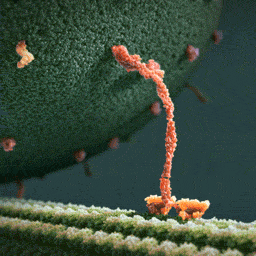One of the coolest gifs on the internet might answer one of the coolest questions: what does happiness look like?
Yes, you might imagine happiness could look like a smile on the face of a calm and relaxed person enjoying rays of sunlight in a beautiful park, or be expressed by excited cheers when their sport team wins. Ultimately, however, happiness is a biochemical experience, triggered by neurotransmitters. If we want to see what happiness really looks like, we’d have to observe the release of chemicals like serotonine, endorphine, dopamine, and oxytocins in the body.
The gif claims to show a molecule of a protein dragging a bag of endorphins inside the parietal cortex. The release of these endorphines results in… happiness!

“This is what happiness really looks like: Molecules of the protein myosin drag a ball of endorphins along an active filament into the inner part of the brain’s parietal cortex, which produces feelings of happiness.”
It’s a great gif, although the caption might cut a few a corners. In reality, it might be a slightly different molecule, it wouldn’t necessarily be in the brain, and the ‘bag’ at the back could also carry other chemicals than endorphines. At least, that’s the diagnose of the science communication blog Eastern blot. Oh, and in case it wasn’t clear, it is an animation drawn up by an animator called John Liebler, and not a recording of what is going on below our skull.
So, what are the main chemicals associated with happiness?
- Serotonine: a mood-booster, emitted when you feel valued or important
- Dopamine: a chemical with many functions, among others released when you experience
- Oxytocin: also duped the trust hormone, and emitted when feeling close contact. (Scholar Paul Zak recommends eight hugs per day to get your dose).
- Endorphines: the star of the gif is emitted in response to pain and helps you persevere when facing a difficult task.
Would you take a pill of happiness?
One of the great things about the gif is that helps to give insight in the many ways you can look at happiness.
Usually I tend to write about the way that humans think about their own happiness, or even how governments or companies evaluate the happiness or quality of life of their citizens/staff. But to a biochemist, those views of happiness would likely be beyond the point. A biochemist might contribute to developing pills treating mental disorders. And indeed, if you were to be given pills that would help the release of the ‘right’ chemicals, our body would feel ‘happy’ – but would we, as individuals, be genuinely happy? Most likely not.
Either way, it is not easy to determine what our brain and our body experience as happiness. We can ask people, but the way we evaluate our happiness does not necessarily give the same result as measuring it. Barring a new innovation that would let us walk around with electrodes on our head measuring all kind of brain activity, it’s hard to know what happiness is really looking like. In the main time, we can fantasise, and enjoy the gif.
